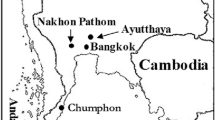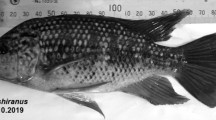Abstract
Blue marlin (Makaira nigricans) stock status varies among ocean basins, and the Atlantic-wide stock is overfished. United States regulations prohibit commercial landing, importation and sale of Atlantic blue marlin, but not of Pacific or Indian Ocean conspecifics. We genotyped 344 blue marlin of known origin and 16 samples used as unknowns at 13 microsatellite loci and the mitochondrial control region. Assignment tests were conducted using GENECLASS2 to investigate the efficacy of available genotypic data to identify individual origin. We successfully discriminated Atlantic and Pacific blue marlin using genetic characters, providing more power to assign marketed blue marlin products to ocean of origin.
Similar content being viewed by others
References
Ball MC, Finnegan LA, Nette T, Broders HG, Wilson PJ (2011) Wildlife forensics: “supervised” assignment testing can complicate the association of suspect cases to source populations. Forensic Sci Int Gen 5:50–56
Bromaghin JF (2008) BELS: backward elimination locus selection for studies of mixture composition or individual assignment. Mol Ecol Res 8:568–571
Buonaccorsi VP, Graves JE (2000) Isolation and characterization of novel polymorphic tetra-nucleotide microsatellite markers from the blue marlin, Makaira nigricans. Mol Ecol 9:820–821
Buonaccorsi VP, Morgan L, Reece KS, Graves JE (1999) Geographic distribution of molecular variance within blue marlin, Makaira nigricans: a hierarchical analysis of allozyme, single copy nuclear DNA, and mitochondrial DNA markers. Evolution 53:568–579
Buonaccorsi VP, McDowell JR, Graves JE (2001) Reconciling patterns of inter-ocean molecular variance from four classes of molecular markers in blue marlin Makaira nigricans. Mol Ecol 10:1179–1196
Chapuis MP, Estoup A (2007) Microsatellite null alleles and estimation of population differentiation. Mol Biol Evol 24:621–631
Cornuet JM, Piry S, Luikart G, Estoup A, Solignac M (1999) New methods employing multilocus genotypes to select or exclude populations as origins of individuals. Genetics 153:1989–2000
Excoffier L, Lischer HEL (2010) Arlequin suite ver 3.5: a new series of programs to perform population genetics analyses under Linux and Windows. Mol Ecol Resour 10:564–567
Finnerty JR, Block BA (1992) Direct sequencing of mitochondrial DNA detects highly divergent haplotypes in blue marlin (Makaira nigricans). Mol Mar Biol Biotechnol 1:206–214
Goudet J (1995) FSTAT version 1.2: a computer program to calculate F-statistics. J Hered 86:485–486
Graves JE, McDowell JR (1995) Inter-ocean genetic divergence of istiophorid billfishes. Mar Biol 122:193–203
Jacquet J, Pauly D (2008) Trade secrets: renaming and mislabeling of seafood. Mar Policy 32:309–318
Manel S, Berthier P, Luikart G (2002) Detecting wildlife poaching: identifying the origin of individuals with Bayesian assignment tests and multilocus genotypes. Conserv Biol 16:650–659
Nakamura I (1985) Billfishes of the world: an annotated and illustrated catalogue of marlins, sailfishes, spearfishes and swordfishes known to date. FAO Fish Synop 125
Ogden R (2008) Fisheries forensics: the use of DNA tools for improving compliance, traceability and enforcement in the fishing industry. Fish Fish 9:462–472
Paetkau D, Slade R, Burden M, Estoup A (2004) Genetic assignment methods for the direct, real-time estimation of migration rate: a simulation-based exploration of accuracy and power. Mol Ecol 13:55–65
Peakall R, Smouse PE (2006) GENALEX 6: genetic analysis in Excel. Population genetic software for teaching and research. Mol Ecol Notes 6:288–295
Piry S, Alapetite A, Cornuet JM et al (2004) Geneclass2: a software for genetic assignment and first-generation migrant detection. J Hered 95:536–539
Primmer CR, Koskinen MT, Piironen J (2000) The one that did not get away: individual assignment using microsatellite data detects a case of fishing competition fraud. Proc R Soc B 267:1699–1704
Rannala B, Mountain BJL (1997) Detecting immigration by using multilocus genotypes. Proc Natl Acad Sci 94:9197–9201
Rousset F (2008) Genepop’007: a complete reimplementation of the Genepop software for Windows and Linux. Mol Ecol Resour 8:103–106
Sønstebø JH, Borgstrøm R, Heun M (2007) Genetic structure of brown trout (Salmo trutta L.) from the Hardangervidda mountain plateau (Norway) analyzed by microsatellite DNA: a basis for conservation guidelines. Conserv Gen 8:33–44
Sorenson L, McDowell JR, Graves JE (2011) Isolation and characterization of microsatellite markers for blue marlin, Makaira nigricans. Conserv Gen Resour 3:721–723
van Oosterhout C, Hutchinson WF, Wills DPM, Shipley P (2004) MICRO-CHECKER: software for identifying and correcting genotyping errors in microsatellite data. Mol Ecol Notes 4:535–538
Withler RE, Candy JR, Beacham TD, Miller KM (2004) Forensic DNA analysis of Pacific salmonid samples for species and stock identification. Environ Biol Fish 69:275–285
Wong EHK, Hanner RH (2008) DNA barcoding detects market substitution in North American seafood. Food Res Int 41:828–837
Acknowledgments
Research was supported by the National Marine Fisheries Service Award NA08NMF4000676 (JRM & JEG). We would like to thank all of our collaborators who provided samples, and Special Agent Lynn Rios for support in Puerto Rico.
Author information
Authors and Affiliations
Corresponding author
Rights and permissions
About this article
Cite this article
Sorenson, L., McDowell, J.R., Knott, T. et al. Assignment test method using hypervariable markers for blue marlin (Makaira nigricans) stock identification. Conservation Genet Resour 5, 293–297 (2013). https://doi.org/10.1007/s12686-012-9747-x
Received:
Accepted:
Published:
Issue Date:
DOI: https://doi.org/10.1007/s12686-012-9747-x




